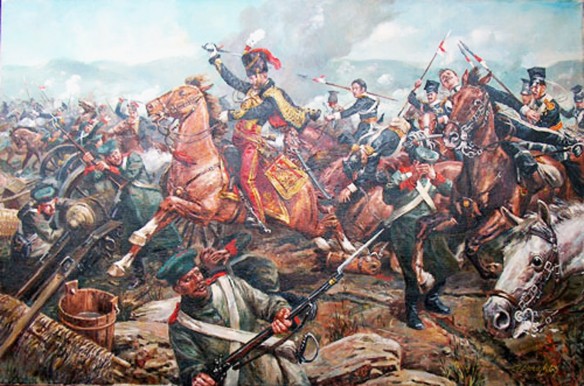
The Charge of the Light Brigade at Balaklava by William Simpson (1855), illustrating the Light Brigade’s charge into the “Valley of Death” from the Russian perspective.
The Charge of the Heavy Brigade at Balaklava by William Simpson. From Simpson’s The Seat of War in the East, second series. The Scots Greys are passing through the cavalry camp and heading toward the Russian cavalry off picture to the left. View from the Russian side toward Balaklava in the far background
At 8.30 am the second phase of the Battle of Balaclava began. As 2,300 Russian cavalry supported by 26 field guns advanced westwards along North Valley, four squadrons (400 men) wheeled over the Woronzov Heights close to No. 3 redoubt towards Kadikoi. In the area of a knoll north of the village, they were driven back by 700 British and 1,000 Turkish troops plus Captain G. R. Barker’s field battery in an action known as ‘The Thin Red Line’. By 9 am the second phase of the battle was over. So far, one phase to each side.
However, the main Russian body was still in the North Valley. Its fate would be decided by Raglan’s Second Order, framed to combat the squadrons effectively seen off by Campbell. The British commander sent Captain Hardinge to Lucan: ‘Eight squadrons of Heavy Dragoons to be detached towards Balaclava to support the Turks, who are wavering.’ By the time that Scarlett and this body was under way, ‘The Thin Red Line’ had prevailed. Then a greater menace appeared on Scarlett’s left flank: almost 2,000 Russian cavalry bearing down in the vicinity of the unoccupied No. 5 redoubt. Calmly turning his regiments to face the enemy, Scarlett led them uphill in two waves, although heavily outnumbered. For some reason the enemy mass halted and, incredibly, the Heavy Brigade drove them back over the Woronzov Heights towards the Tchernaya in confusion. The Times’ correspondent, W. H. Russell, recorded that ‘a cheer burst from every lip – in the enthusiasm officers and men took off their caps and shouted with delight’. In his later dispatch, Raglan referred to the Heavy Brigade Charge (in which a mere 78 casualties were incurred) as ‘one of the most successful I ever witnessed’.
There was a bitter postscript. The Light Brigade had sat motionless on Scarlett’s left as he charged. Cardigan claimed that Lucan warned him to act only if the enemy attacked; Lucan insisted that he urged him merely to ‘be careful of columns or squares of infantry’. Once more the brothers-in-law were at loggerheads, a state of mind which would have even more serious consequences later that morning. It was still only 9.30 am.
Above the plain, Raglan could see the beaten enemy cavalry milling around the far end of North Valley, leaving infantry exposed on the Woronzov Heights and Fedioukine Hills. The enemy was wavering; the time ripe for decisive action. At 10.15 am he sent the Third Order to Lucan: ‘Cavalry to advance and take advantage of any opportunity to recover the Heights. They will be supported by the infantry which have been ordered. Advance on two fronts.’ Lucan had been in the South Valley all morning: the ‘Heights’ could only mean the Woronzov Heights, where the Russians were in possession of Nos 1-3 redoubts; ‘two fronts’ the North and South valleys. Lucan’s immediate action suggests that he did understand the order: he moved the Light Brigade into the North Valley, kept the Heavy Brigade in the South Valley and himself took post at the end of the Woronzov Heights between them. But the infantry were delayed and by 10.30 am were not on the plain.
Raglan could see Russian artillerymen preparing to tow away the guns captured in the redoubts. Although spiked, they could be repaired and used against the allies. At about 10.40 am, he therefore dictated the fateful and controversial Fourth Order, which his Quartermaster-General, Richard Airey, copied down: ‘Lord Raglan wishes the cavalry to advance rapidly to the front, and try to prevent the enemy taking away the guns. Troop of horse-artillery may accompany. French cavalry is on your left. Immediate.’ As Airey’s ADC, Captain L. E. Nolan, left the ridge with the order, Raglan called after him, ‘Tell Lord Lucan the cavalry is to attack immediately.’ What then happened between Lucan and Nolan will never be known. Undoubtedly, Raglan intended his third and fourth orders to be read in conjunction with one another, the cavalry to move on the redoubts without waiting for the absent infantry. Lucan later maintained that, when questioned by him, Nolan pointed to the end of the North Valley, where Russian field guns were drawn up to protect the Tchernaya river crossings.
So, shortly after 11 am, Cardigan led 673 men from the Light Brigade plus Nolan, who secured permission to ride with it, up the 1.25-mile-long (2km) valley to be immortalised in Tennyson’s epic poem. Twenty minutes later, the shattered remnants returned: 113 men had been killed and 247 badly wounded, 475 horses killed and 42 injured. French cavalry cleared the Fedoukine Hills to protect their right flank as the survivors came back; Lucan was wounded leading the Heavy Brigade to cover them; Nolan was killed shortly after the brigade commenced its advance. He died in front of Cardigan, waving his sword in the air. Quite what he meant by this action remains in dispute. Perhaps he was trying to redirect the brigade towards the redoubts, as A. W. Kinglake later concluded and countless writers since have repeated.
Scarcely had the last trooper dismounted under the Sapoune Ridge than recriminations started. Raglan censured Cardigan, who pointed to an order from Lucan (‘my superior officer’), and the divisional commander laid the blame on Nolan, who could no longer defend himself.